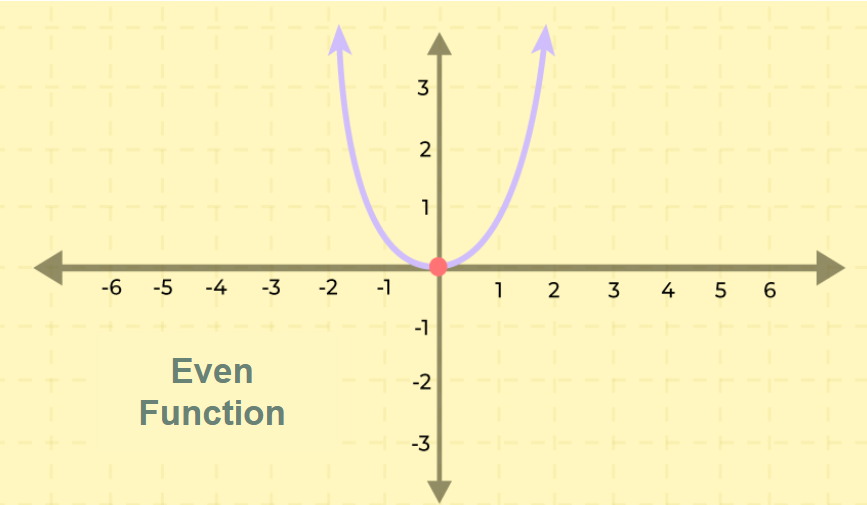
|
|
Even and odd functions are types of functions. A function f is even if f(-x) = f(x), for all x in the domain of f. A function f is an odd function if f(-x) = -f(x) for all x in the domain of f, i.e.
In this article, we will discuss even and odd functions, even and odd function definitions, even and odd functions in trigonometry, and even and odd function graphs and others in detail. Table of Content
What are Even and Odd Functions?In mathematics, there are various kinds of functions that we examine. We can use algebra or graphics to determine whether a function is even or odd. Whereas, if a function f(x) meets the following condition for every x in its domain:
On the other side, if a function f(x) meets the following condition for every x in its domain:
Even and Odd Functions DefinitionA real-valued function is regarded as even or odd that is symmetrical. Plugging (-x) in place of x in the function f(x) allows us to detect if a function is even or odd. Therefore, we may determine the type of function by looking at the output value of f(-x). So, let’s see the following definitions that are given below: Even FunctionWhen all values of x and −x in the domain of f satisfy the following equation, the function “f” is considered even:
Here, “Even” is symmetric about the y-axis indicating the graphical Function that would stay unmodified if you were to represent it across the y-axis. Even Function ExamplesExamples of even functions includes:
Even and Odd Functions GraphLet’s explore the graphical behavior of even and odd functions. An even function’s graph is symmetric around the y-axis, meaning it looks the same when reflected across the y-axis. For any pair of opposite x-values, the function’s y-values are identical along the curve. On the other hand, an odd function’s graph is symmetric with respect to the origin. This means the graph is equidistant from the origin but in opposite directions. For any pair of opposite x-values, the function’s y-values are also opposite. Here are some examples of even and odd functions. Even Functions GraphAn even function’s graph is symmetric about the y-axis and stays unchanged after reflection of the y-axis. Along the whole curve, the function value will not change for any two opposing input values of x.
Odd FunctionWhen all values of x and −x in the domain of f satisfy the following equation, the function “f” is considered odd:
Here, “Odd” is symmetric in that the graphical function would remain unchanged if it were rotated 180 degrees around the origin. Odd Function ExamplesExamples of odd functions includes:
Odd Functions GraphAn Odd function’s graph is symmetric concerning the origin that lies at the same distance from the origin but faces different directions. Whereas the function has opposite y values for any two opposite input values of x.
Neither Odd Nor EvenIf a real-valued function f(x) does not fulfill f(-x) = f(x) and f(-x) = -f(x) for at least one value of x in the function’s domain, it is considered to be neither even nor odd (x). Suppose f(x) = 2x5 + 3x2 + 1 f(-x) = 2(-x)5 + 3(-x)2 + 1 f(-x) = -2x5– 3x2 + 1 (Both conditions failed) Therefore, f(x) = 2x5 + 3x2 + 1 is neither “Even” nor “Odd” Function. Even and Odd Functions in TrigonometrySix trigonometric ratios are:
Now for these trigonometric functions,
Properties of Even and Odd FunctionsSome of the properties of Even and Odd Functions are given below.
Integral Properties of Even and Odd FunctionsIntegrals over symmetric intervals can be made simpler by using the distinct integral features of even and odd functions. These are as follows: Even FunctionsWhen f(x) is an even function, its integral over the symmetric interval [−a, a] can be reduced as follows:
Due to its symmetry about the y-axis, the graph of an even function has this property. Integrating over a symmetric interval effectively doubles the area under the curve on one side, so we only need to compute half of it. Odd FunctionsWhen f(x) is an odd function, its integral over the symmetric interval [−a, a] can be reduced as follows:
The rotational symmetry of the odd function’s graph origin gives birth to this characteristic. The net area is zero when the integration across a symmetric interval eliminates the positive and negative regions. Read More Even and Odd Functions ExamplesExample 1: Using the notion of even and odd functions, ascertain if the function f(x) = Cosh(x) is even or not. Solution:
Example 2: Identify whether the function f(x) = x4 + 2x2 -3 is even, odd, or neither. Solution: For Even Function:
Practice Questions on Even and Odd FunctionsQuestion 1: Determine if the function g(x) = 1/x2 is even, odd, or neither. Question 2: Identify whether the function f(x) = x3+ x is even, or odd or neither. Question 3: Identify if the function m(x) = ex + e-x is even, odd, or neither. Even and Odd Functions – FAQsWhat is Odd and Even Function?
How can you tell if a function is even or odd?
What are some examples of Odd Functions?
What are some examples of Even Functions?
Can functions be neither Even nor Odd?
|
Reffered: https://www.geeksforgeeks.org
| Mathematics |
| Related |
|---|
| |
| |
| |
| |
| |
Type: | Geek |
Category: | Coding |
Sub Category: | Tutorial |
Uploaded by: | Admin |
Views: | 13 |
